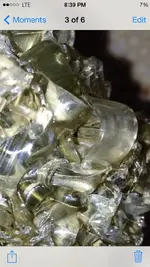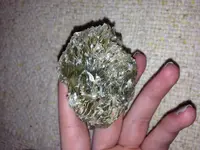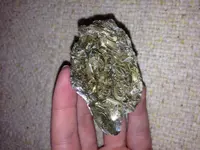Hi guys, my daughter found this piece while looking for Indian relics. It is clear like glass, has the same density as glass. We are not sure if this is glass that was melted in a fire or what. Has unusual loops on the edges as can be seen in the pictures. Any input appreciated, thanks.
You are using an out of date browser. It may not display this or other websites correctly.
You should upgrade or use an alternative browser.
You should upgrade or use an alternative browser.
Glass?
- Thread starter scratcher
- Start date
nhbenz
Gold Member
- Joined
- Dec 30, 2004
- Messages
- 6,821
- Reaction score
- 6,848
- Golden Thread
- 0
- Location
- Brentwood, NH
- Detector(s) used
- White's Classic SL
White's Surf P.I.
That is very odd. Do you live anywhere near an old glass blowing factory? It looks like part of the recycle pile from such a place, which hadn't yet been fully melted down.
Upvote
0
mwb76
Jr. Member
- Joined
- Nov 20, 2011
- Messages
- 50
- Reaction score
- 99
- Golden Thread
- 0
- Location
- chester county pa
- Detector(s) used
- whites xlt
- Primary Interest:
- All Treasure Hunting
Are you sure it's glass not some weird crystal if it's glass I agree with nhbenz looks like left over glass trimming
Upvote
0
Tommy G
Bronze Member
First let me say that I am no geologist, nor could I play one on TV. Having established my complete lack of credentials, I would offer that as a kid I collected and studied all kinds of rock formations, so the first thing that struck me was your reference to fire, which may be part of the answer. There are two types of natural glass; volcanic (the most common form being obsidian or "black glass"), and fulgurite which is the product of lightning striking the ground. The most common fulgurite examples you will see on the internet are the result of lightening strikes in sandy areas and they look nothing like this; however, there are many examples of fulgurite in different shapes and colors. Lightning strikes the ground at 3,000+ degrees F. Like Forrest Gump's box of chocolates, you never know what you're going to get. It all depends on the mineral content at the point of impact. It is super heated, then immediately cooled by the rain which causes the "splattered" look. Again, this is only one possible answer. I would take this to the closest university with a good geology department and have them examine it to get the final answer. Thanks for sharing!
Last edited:
Upvote
0
DCMatt
Gold Member
- Joined
- Oct 12, 2006
- Messages
- 10,472
- Reaction score
- 13,785
- Golden Thread
- 0
- Location
- Herndon Virginia
- Detector(s) used
- Minelab Equinox 600, EX II, & Musketeer, White's Classic
- Primary Interest:
- Metal Detecting
You don't say where it was found.
Any chance you were in the path of the space shuttle disaster?
DCMatt
Any chance you were in the path of the space shuttle disaster?
DCMatt
Upvote
0
digger460
Silver Member
- Joined
- Sep 19, 2015
- Messages
- 2,972
- Reaction score
- 3,297
- Golden Thread
- 0
- Location
- Southeast Grundy, Illinois
- Detector(s) used
- EQ600, EQ800 and a Carrot
- Primary Interest:
- Other
Cool piece, whatever it is. Keep us posted if you find out what it is.

Upvote
0
Similar threads
- Replies
- 4
- Views
- 385
Users who are viewing this thread
Total: 1 (members: 0, guests: 1)







